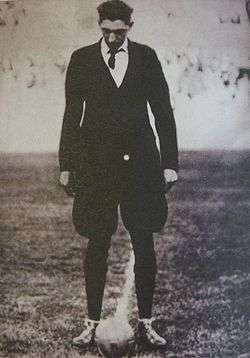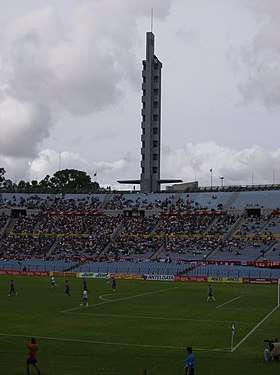Estadio Centenario
Estadio Centenario is a stadium in the Parque Batlle neighborhood of Montevideo, Uruguay, used primarily for football. The stadium was built between 1929 and 1930 to host the inaugural 1930 FIFA World Cup, as well as to commemorate the centennial of Uruguay's first constitution. It is listed by FIFA as one of the football world's classic stadiums.[3] On July 18, 1983, it was declared by FIFA as the only historical monument of World Football, the only building of its kind worldwide.[4][5]
.jpg) Estadio Centenario in 2017 | |

| |
| Full name | Estadio Centenario |
|---|---|
| Location | Avenida Dr. Américo Ricaldoni y Federico Videla, Parque Batlle, Montevideo, Uruguay |
| Coordinates | 34°53′40″S 56°9′10″W |
| Owner | Montevideo Departmental Government |
| Operator | Uruguayan Football Association |
| Capacity | 60,235 [1] |
| Record attendance | 79,867 (Uruguay-Yugoslavia, 27 July 1930)[2] |
| Field size | 105 x 68 m |
| Surface | Grass |
| Construction | |
| Broke ground | 21 July 1929 |
| Built | 1929–1930 (8 months) |
| Opened | July 18, 1930 |
| Construction cost | $1,000,000 |
| Architect | Diego Alberto Scasso |
| Tenants | |
| Uruguay national football team (1930–present) Montevideo City Torque (2018–present) | |
Estadio Centenario is the primary home of the Uruguay national team. Uruguay has always been a threat when playing in their home stadium, consistently beating top teams. Even the top ranked Brazil national football team has only managed three wins in 20 opportunities; two were official matches during 2010 and 2018 World Cup qualification, but one was Uruguay's heaviest defeat at the stadium, when they lost 4–0 to Brazil in 2009.
History
The construction of the Centenario is one of the most important stages in the development of sports in South America and international football. It was built especially for the organization of the 1930 FIFA World Cup, by immigrant workers in a record time of nine months. Its name originates from the celebration of 100 years of the ratification of the first Constitution of Uruguay.
Initially, all World Cup matches were to be played in the Centenario. However, heavy rains in Montevideo delayed construction of the stadium, so that several matches had to be played in the Pocitos Stadium of Club Atlético Peñarol, and the Parque Central of Club Nacional de Football. It was inaugurated on July 18, 1930, in the match between Uruguay and Peru, with the Celeste gaining victory 1–0, with a goal by Hector "Manco" Castro.[6]

The final match of the inaugural World Cup matched Uruguay and Argentina, with Uruguay winning 4–2.[7] Since then, the Centenario has been the scene of Copa América (1942, 1956, 1967, 1995), three South American Youth Championships (1979, 2003, 2015), a South American Under-17 Football Championship (1999) and 1980 Mundialito.
Tenants

Aside from the Uruguay national team, any football club can rent the stadium for its home matches.[5] Peñarol has done that often,[8] and Nacional rents it for some international matches.[9] Peñarol played all of its home matches at the stadium from 1933 until it moved to Estadio Campeón del Siglo in 2016.
In the case of other Uruguayan teams, they often decide to play there against both Peñarol and Nacional.[8][9]
Grandstands
The stadium has four Grandstand separated by four lanes. The main one is the Olympic Tribune (and lower Platea known as Olympic), which is named so because the team had won two Olympic championships in a row (1924 and 1928). This has a maximum capacity of 21,648 spectators located in the three rings and the audience.[1] Then there are the "popular", so called because they are sold cheaper, these are: the Colombes, in honor of the Colombes, France in which the national team became Olympic champions 1924 and Amsterdam, because it was where the Celeste were crowned Olympic champions for the second time in 1928. The Grandstand Colombes accommodates 13,914 spectators while the Amsterdam accommodates 13,923.[1] The America Tribune is parallel to the Olympic one. There are also "VIP" boxes and press boxes with room for 1,882 spectators, as well as the platform has room for 2,911 spectators, and additionally the grandstand has room for 5,957 people.[1]
Under the Olympic Grandstand are located primary school "Nº 100 Héctor Fígoli"; and the Museum of Uruguayan Football. Under the Colombes Grandstand is located Police Station Nº9.
Concerts
The stadium has held numerous concerts by both national and international artists such as:[10]

- Aerosmith
- Amaral
- Árbol
- Arnaldo Antunes
- Attaque 77
- Brian May
- Bryan Adams
- Buitres Después de la Una
- Charly García
- Chayanne
- Enrique Iglesias
- Eric Clapton
- Fito Páez
- Guns N' Roses
- Joaquín Sabina
- Joe Cocker
- Joe Vasconcellos
- Jorge Drexler
- Los Olimareños
- Los Piojos
- Luciano Pavarotti
- Luis Miguel
- Maná
- No Te Va Gustar
- Nortec Collective
- One Direction
- Patricio Rey y sus Redonditos de Ricota
- Paul McCartney
- Plácido Domingo
- ReyToro
- Ricardo Arjona
- Rod Stewart
- Roger Waters
- Roxette
- Rubén Blades
- Sebastian Bach
- Serú Girán
- Soledad Pastorutti
- Soy Luna Live
- Sting
- Sui Generis
- The Rolling Stones
- Teen Angels
- The Cult
1930 FIFA World Cup
Estadio Centenario hosted ten games of the 1930 FIFA World Cup, including the opening and the final matches.
| Date | Time | Team No. 1 | Res. | Team No. 2 | Round | Attendance |
|---|---|---|---|---|---|---|
| 18 July 1930 | 14:30 | 1–0 | Group 3 | 57,735 | ||
| 19 July 1930 | 12:50 | 1–0 | Group 1 | 2,000 | ||
| 19 July 1930 | 15:00 | 6–3 | Group 1 | 42,100 | ||
| 20 July 1930 | 13:00 | 4–0 | Group 2 | 25,466 | ||
| 20 July 1930 | 15:00 | 1–0 | Group 4 | 12,000 | ||
| 21 July 1930 | 14:50 | 4–0 | Group 3 | 70,022 | ||
| 22 July 1930 | 14:45 | 4–1 | Group 1 | 41,459 | ||
| 26 July 1930 | 14:45 | 6–1 | Semi-final | 72,886 | ||
| 27 July 1930 | 14:45 | 6–1 | Semi-final | 79,867 | ||
| 30 July 1930 | 14:15 | 4–2 | Final | 68,346 |
References
- INSTALACIONES
- 1930 FIFA World Cup Uruguay ™ - Matches - Uruguay-Yugoslavia - FIFA.com
- FIFA.com
- The mythical Centenario stadium, a "Historical Monument of Football", welcomes the finals of the U-20 Sudamericano Tournament, January 25, 2015
- HISTORIA (in Spanish)
- First Goal html
- 1087/report.html1/results/matches/match=1930
- Peñarol - Matches
- Nacional - Matches
- Conciertos en Uruguay
External links
| Wikimedia Commons has media related to Estadio Centenario. |
| Preceded by None |
FIFA World Cup Opening Venue 1930 |
Succeeded by All 8 venues used for the 1934 FIFA World Cup, matches on the first day were all played at the same time |
| Preceded by None |
FIFA World Cup Final Venue 1930 |
Succeeded by Stadio del PNF Rome |
| Preceded by Estadio Nacional de Chile Santiago |
South American Championship Final Venue 1942 |
Succeeded by Estadio Nacional de Chile Santiago |
| Preceded by Estadio Monumental Isidro Romero Carbo Guayaquil |
Copa América Final Venue 1995 |
Succeeded by Estadio Hernando Siles La Paz |